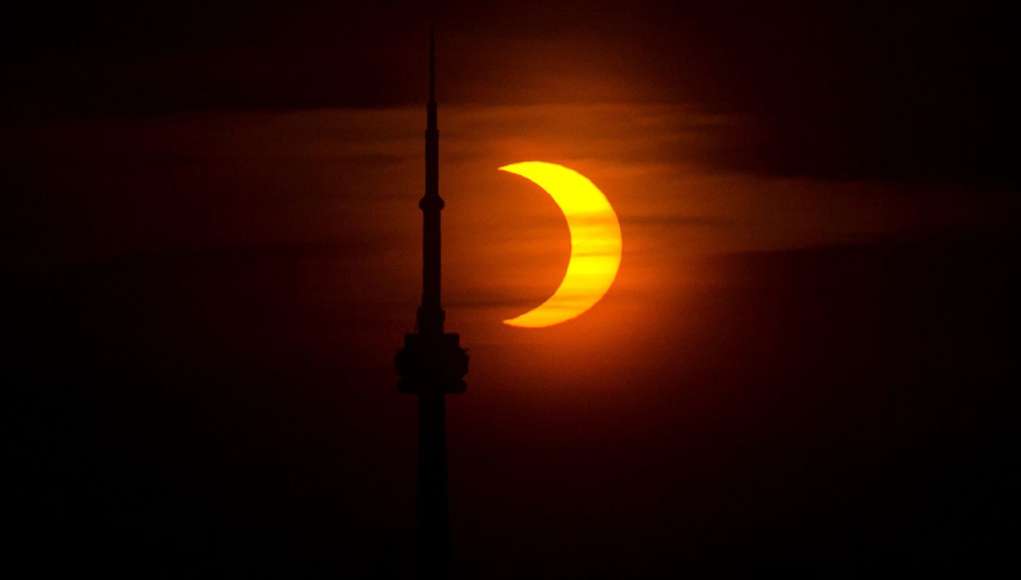When the moon passes between the sun and Earth for the second time this year, it will block most light from the sun and cast its shadow onto our planet, resulting in a bright, fiery crescent shape in the sky.
This solar eclipse will be happening this Tuesday and will be visible in parts of Greenland, Iceland, most of Europe, northeast Africa, and western and central Asia. It will last for nearly four hours beginning at 5 a.m. ET, or through the early afternoon most of for those in the Eastern hemisphere.
Since the sun, moon and Earth will not be perfectly lined up, it will be a partial eclipse — hence the crescent shape of the sun’s light, which will appear to peek out from underneath the moon. At the maximum eclipse, where there will be the most coverage of the sun, approximately 86% of the sun will be covered, according to EarthSky.
The moon will be nearly four days from its perigee, its closest point to Earth in its 27-day orbit, during the eclipse, and thus will appear the slightest bit larger than usual.
Those who can view the eclipse near the maximum will be able to see a crescent-shaped sun pointed upward, almost as if there were a bite taken out of it, according to Michael Kirk, the principal investigator of NASA’s Heliophysics Education Activation Team.
“When you go out and you see a solar eclipse, whether it’s a partial eclipse or whether it’s a total eclipse, which are really special, you end up feeling like you’re part of this whole celestial dance between the Earth and sun and moon,” Kirk said. “And it gives you a sense of place … this is where you are in the solar system, which is so vast.”
Safely viewing solar and lunar eclipses
It is not safe to look at the sun’s rays without protective eyewear, even when the sun is mostly covered by the moon. It is important to wear eye protection that meets the international standards to be considered proper “eclipse glasses,” according to the American Astronomical Society.
It is also not advisable to look at the sun through an unfiltered camera, telescope, binoculars or other optical device either, even while using proper eyewear.
A solar eclipse always occurs about two weeks before or after a lunar eclipse, when the full moon will enter the Earth’s shadow, giving the moon a reddish hue. This is due to the placement of the sun, moon and Earth, which are nearly in a flat plane but have a wobble to their orbit. A solar eclipse occurs when the sun, moon and Earth are aligned, with the moon in a new moon phase; within two weeks, the sun, Earth and full moon will align with the Earth and moon changing places in their orbit and causing a lunar eclipse, according to Kirk.
This upcoming partial solar eclipse will be followed by a total lunar eclipse of the full moon exactly two weeks later on Nov. 8, according to The Old Farmer’s Almanac. Unlike a solar eclipse, which is only visible in a relatively small area of the world, a lunar eclipse can be seen from anywhere on the night side of Earth.
Also unlike a solar eclipse, viewing a lunar eclipse does not require any safety gear.
The next opportunity to see a solar eclipse will not be until April 20, 2023, when there will be an annular solar eclipse visible to Australia, Antarctica and Southeast Asia, according to NASA, and will cause a complete ring of fire surrounding the moon.
“This partial eclipse is really a preview to next year,” Kirk said. “We’re looking for this one to really get us ready and charged up, and get the word out about the annular eclipse.”
Other space events this year
While this partial solar eclipse and total lunar eclipse will be the last to see for the remainder of 2022, there are other space happenings to eye in the sky this year. Two more full moons will fall on November 8 (the Beaver moon) and December 7 (the Cold moon), and there are five more meteor showers on the calendar too, according to EarthSky’s 2022 meteor shower guide:
• November 5: South Taurids
• November 12: North Taurids
• November 18: Leonids
• December 14: Geminids
• December 22: Ursids










